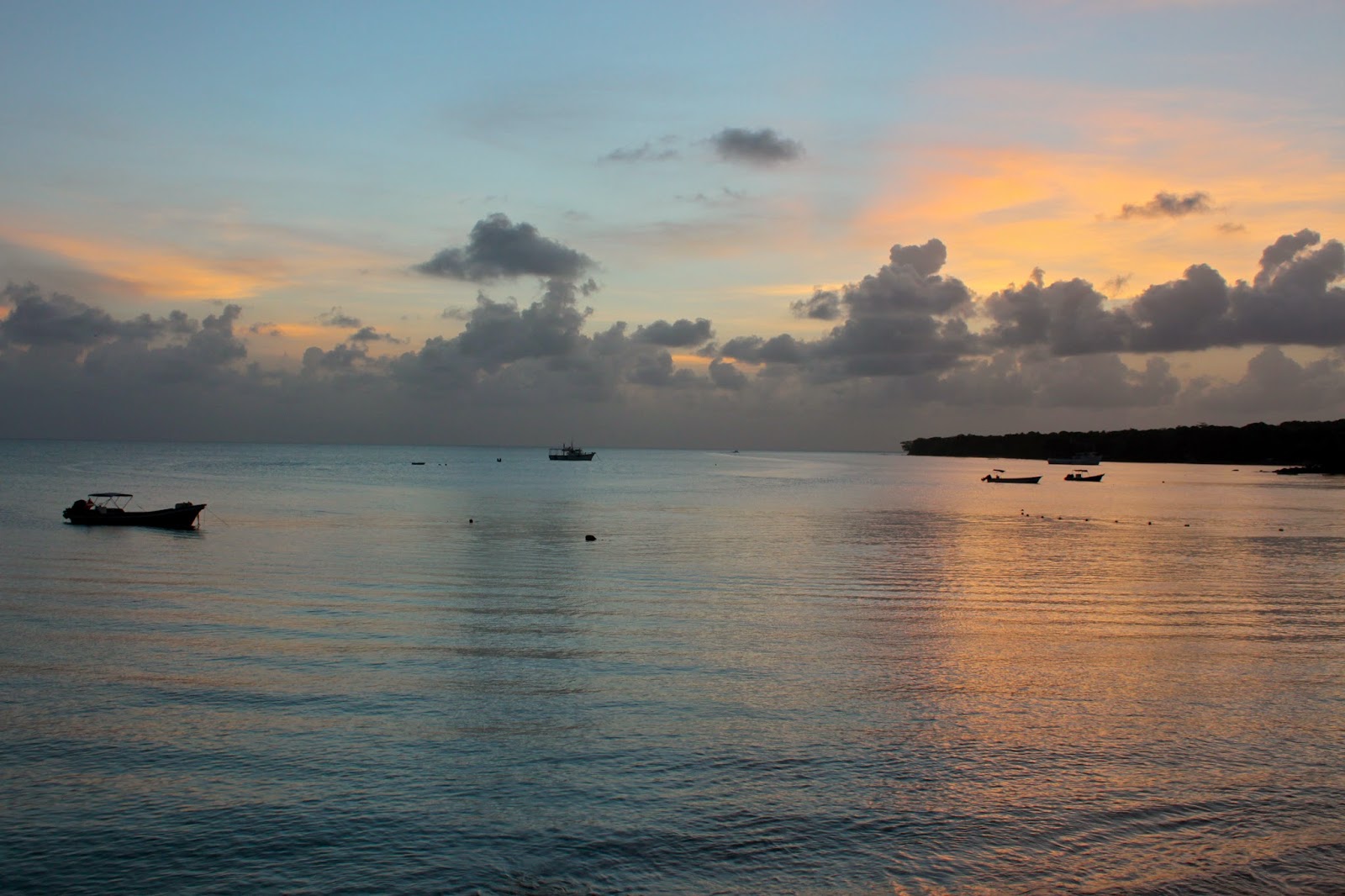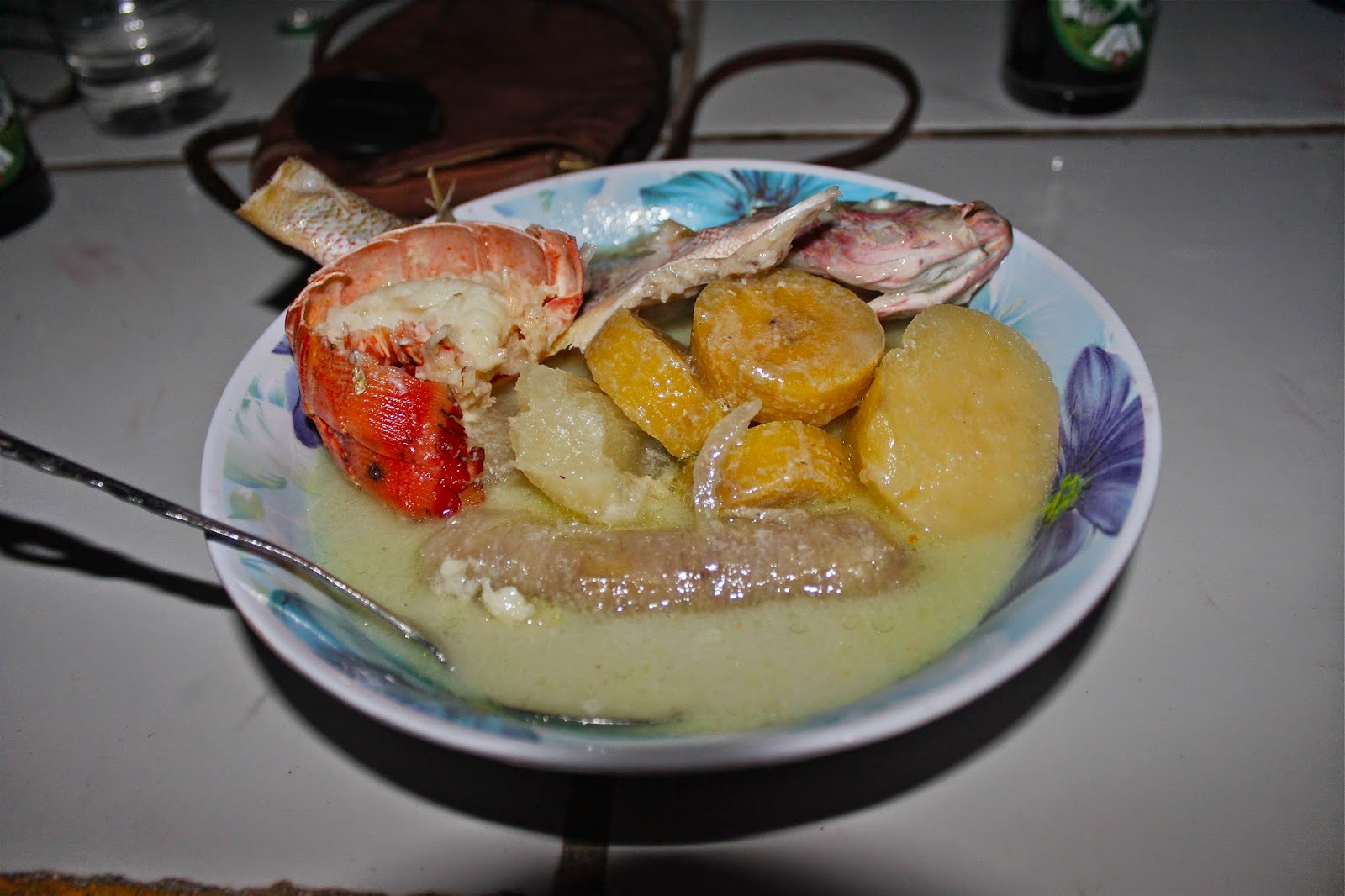Crystal clear Caribbean waters, pristine private beaches, and an incredible island culture make up Las Islas de Maíz, or, The Corn Islands. These islands are located about 70 km. off the eastern coast of Nicaragua. At one point in time, these islands were frequented by pirates and under a treaty in 1914 were actually leased to the United States for a period of 99 years. During this time they were subject to U.S. law but property of Nicaragua. Fortunately, with the lease notwithstanding, the U.S. never maintained a significant presence on the islands.
We left Surfing Turtle early and bussed to Managua to catch an afternoon flight to Big Corn. From there we took an extremely entertaining boat ride over to Little Corn Island. We were getting so much air in the front of the boat that our stomachs were all dropping repeatedly the entire boat ride.

Our front yard for the week.
"Steadman's Place". While in a cab on Big Corn, we were explaining to our cab driver how we had no idea yet as to where we were staying. He rolled down his window, shouted to a man walking on the street in a creole language (a blend of Spanish and English with a whole lot of Caribbean flair to it), and bam. He found a place for us. As we got off the boat, now on Little Corn, the man he'd spoken to, Steadman, found us and brought us to his place. $10 a night and he could cook for us at any time if we just gave him a heads up. It was perfect.
The inside of Melissa and my cabin.
Piña Coladas & euchre were staples in our time spent here
More of Steadman's Place - the green house is Steadman's and there's Melsie doing her laundry the good ol' fashioned way.
The window above my bed (which was definitely a hot spot for hundreds of ants, but when you wake up to a view of teal caribbean waters not much else matters).
To get from our huts to other parts of the island you could either cut inland, through small, unmarked dirt paths, or walk along the beach to another path bringing you into "town", which was simply a slightly more populated street with a few restaurants.
Most of the hostels on the island were something like this. Huts & hammocks, all beachside and surrounded by palm trees and silky smooth white sand.
Steadman came to this island a few decades ago and decided he'd never leave. At the time of his arrival, a mere 15 families lived on the island. Now several more do but only about 1,200 people reside here. The islanders are English-speaking Creole people of mixed black heritage. In recent years more Spanish-speaking mestizos have come to the islands from the Pacific side of Nicaragua as well as Miskito people from the Caribbean mainland. English is now being supplanted by Spanish and Miskito.
The houses were a wonderful array of colors, often matching the beautiful shades of the surrounding waters and blue skies.
We sat on this beach for over an hour and never saw anyone else
If you weren't walking along the beach you were walking on a path somewhat like this. We'd often get lost while attempting to follow islanders directions, but they were always quick to help you themselves or find someone else to accompany you.
There were some woodsy areas in parts and other areas were more open fields where cattle roamed and grazed freely. Nicaragua is said to have some of the best, grass-fed beef in all of Central America. We had some kabobs and filets that were incredible, by far the best.
On Sunday, after making us breakfast, Steadman let us know he'd be playing baseball and to stop by if we wanted to. After struggling to find where the baseball field was, despite very detailed directions, a local kid, Chris, showed us the way through woods and up into a part of the island we hadn't see yet. If he hadn't pointed out these paths, I'm certain we would have continued to walk right past them. We walked along, enjoying the unparalleled peacefulness of the island. No matter where you were on the island you could always hear the sounds of the water. We moseyed along and all of the sudden we could hear reggae music playing in the distance. Before we knew it we came to a clearing. We had found the baseball field.
We were a bit surprised to see what a big event it was. It seemed like the whole island was there, locals and tourists alike, enjoying the Sunday baseball game. We had expected to find a low-key pickup game of sorts, so to find a grandstand and happening organized event was an exciting discovery. Reggae music played along to the cracks of baseballs against wooden bats and jeers in Meskito and Creole. Kabobs sizzled on charcoal grills and cold beers in coolers awaited us. It was the best way to spend a Sunday afternoon on Little Corn.
Afterwards, we stopped by the island's "Lighthouse", where you could climb to the top and have a great view of the entire island.
Little Corn is only slightly larger than 1 square mile, allowing you to see it in it's entirety easily.
Above is the stretch of water in front of Steadman's Place.
View from breakfast one morning. Men passed with carts and wheel-barrels, hauling anything from food to wood to ice to other parts of the island.
Grounds of a hostel located on the northern shores of the island where the best snorkeling and reefs were located. I felt like I was in hobbit land with little huts and mossy humps of soft grass amongst palm trees and forest.
The construction of hostels always fascinates me. People really get creative with their decorating, often reusing things many would never think of. Old rum bottles were used a lot here, filled with different colored waters to add some flair. Above, the faucet of the sink is also a bottle. Pretty cool.
No shoes. We rarely wore shoes here and it was no bother to anyone. Restaurants, bars, wherever. Some even requested you didn't wear any. Laid back island life to the max.
Another totally empty, beautiful beach
Sway exploring the tide pools that are all over just off shore
Many places on the island need notice if you'll be eating there. Earlier that day or sometimes even the night before so that they can be sure to have enough fresh catches and ingredients ready. One night, we enjoyed the island "plato típico" (typical dish) - "The Rondon". Also seen on signs as "The Rundown". We figured Rondon was actually meant to be Rundown, but when you add the accent of the locals, you get Rondon. Ya mon. This man cooked us up the incredibly delicious dish.
A blend of plantains, bananas, yucca, onions, whole fish, shrimp, and lobster tails are cooked in a sweet, yet salty, creamy coconut milk broth. I'll forever crave this.
Coco locos were also provided. A.k.a. rum poured in a freshly opened coconut. We dined waterside under a clear night sky, with only a small fire providing a little bit of light.
A local man came and played music for us, singing lots of Bob Marley as well as original calypso songs he'd written.
Home
Sunrise on Little Corn
The beloved Steadman
Our neighbor - the man with the yellow afro.

On the last day, we had a whole meal cooked for us. Josh had found this woman the night before and had the most incredible plate of food, we asked if she could cook for us the next day before leaving the island. She was thrilled to do so and was so passionate about cooking. She said she could do fish, only if her brother-in-law speared some that morning, but otherwise she could do a filet mignon, ginger stir fry chicken, and a Coca-Cola glazed pork roast. We had the latter and it was all delicious - served with coconut rice, potato salad and coleslaw with beets. We ate on the beach before catching the boat to the main island.
This was the plane we took back to the mainland. A tiny 12 passenger guy. It was surprisingly the smoothest, most enjoyable flight I've ever been on. We flew into the sunset over the Caribbean and made it back into Managua by dusk. It was an incredible, relaxing, good time on Little Corn for the week. I hope to go back some day and would recommend it highly to anyone seeking an island getaway.




































































